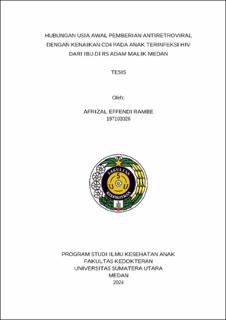Hubungan Usia Awal Pemberian Antiretroviral dengan Kenaikan CD4 pada Anak Terinfeksi HIV dari Ibu di RS Adam Malik Medan
Relationship Between Age of Initial Antiretroviral Treatment and CD4 Increase in Children Infected with Mother's Hiv at Adam Malik Hospital Medan

Date
2024Author
Rambe, Afrizal Effendi
Advisor(s)
Evalina, Rita
Nafianti, Selvi
Metadata
Show full item recordAbstract
Background: More than>90% of HIV infections in children are transmitted vertically. The virus will attack T lymphocyte cells so that T lymphocyte cells will decrease, causing cluster of differentiation 4 (CD4) levels to also decrease. By administering antiretrovirals (ARVs), viral replication can be inhibited so that the number of T cells and CD4 cells increases. Changes and development of the immune system occur with increasing age, so the age at which ARVs are initially administered influences the increase in CD4
Objective: To determine the relationship between the initial age of antiretroviral administration and the increase in CD4 in HIV-infected children of mothers at Adam Malik Hospital, Medan.
Methods: An analytical observational study using a retrospective cross-sectional method was conducted to determine the relationship between age at the start of antiretroviral administration and the increase in CD4 in children infected with HIV from mothers. Sampling was taken using consecutive sampling from medical records with a sample of 30 children. Fisher's exact test was used for bivariate analysis of children.
Results: From the data, it was found that the highest age at which ARVs were administered was 17 people (56%), and 10 people under five (33%). In this research sample there was no relationship between the initial age of ARV administration and the increase in CD4 (p=1,000), gender (p=1,000), nutritional status (p=1,000). There was a relationship with the absence of opportunistic infections on the increase in CD4 (p=0.009).
Conclusion: There is no relationship between the initial age of ARV administration and the increase in CD4, gender, and nutritional status. There is a relationship with the absence of opportunistic infections on the increase in CD4.
Collections
- Master Theses [362]
